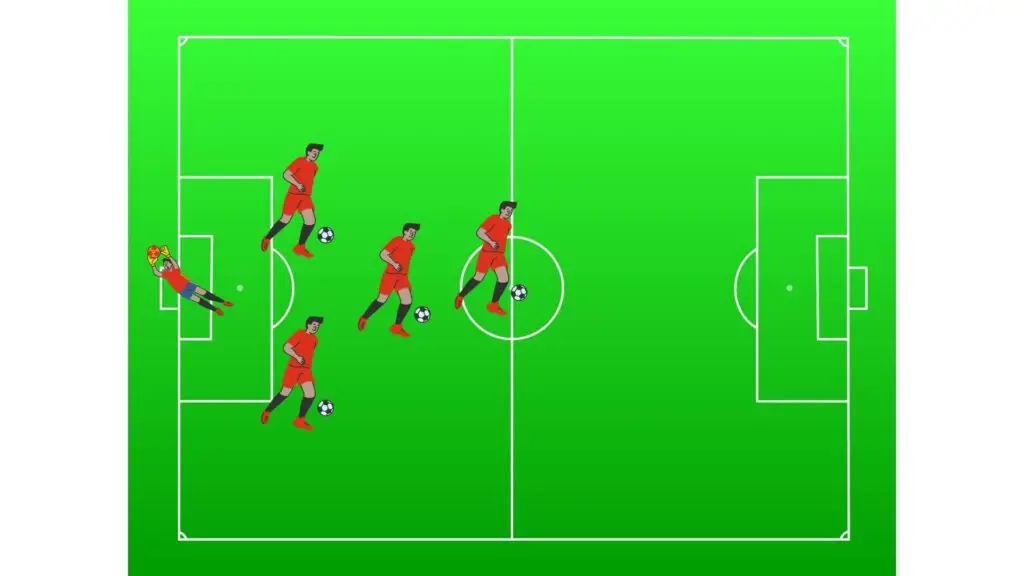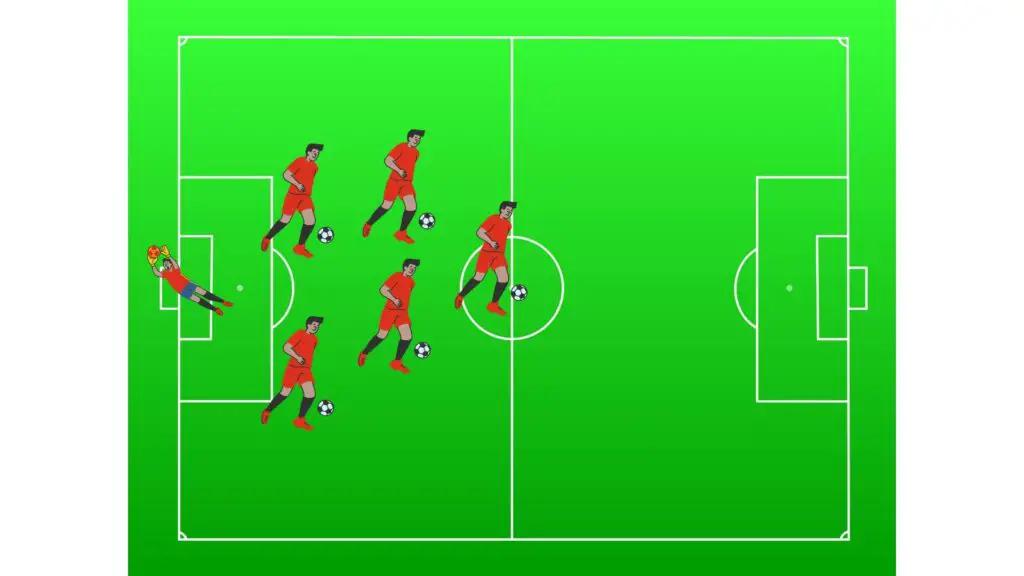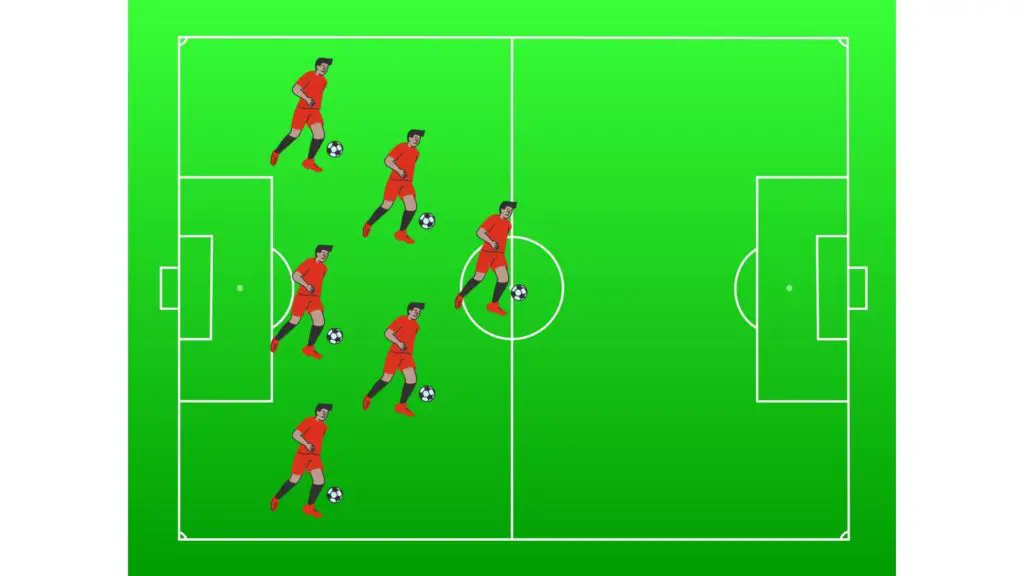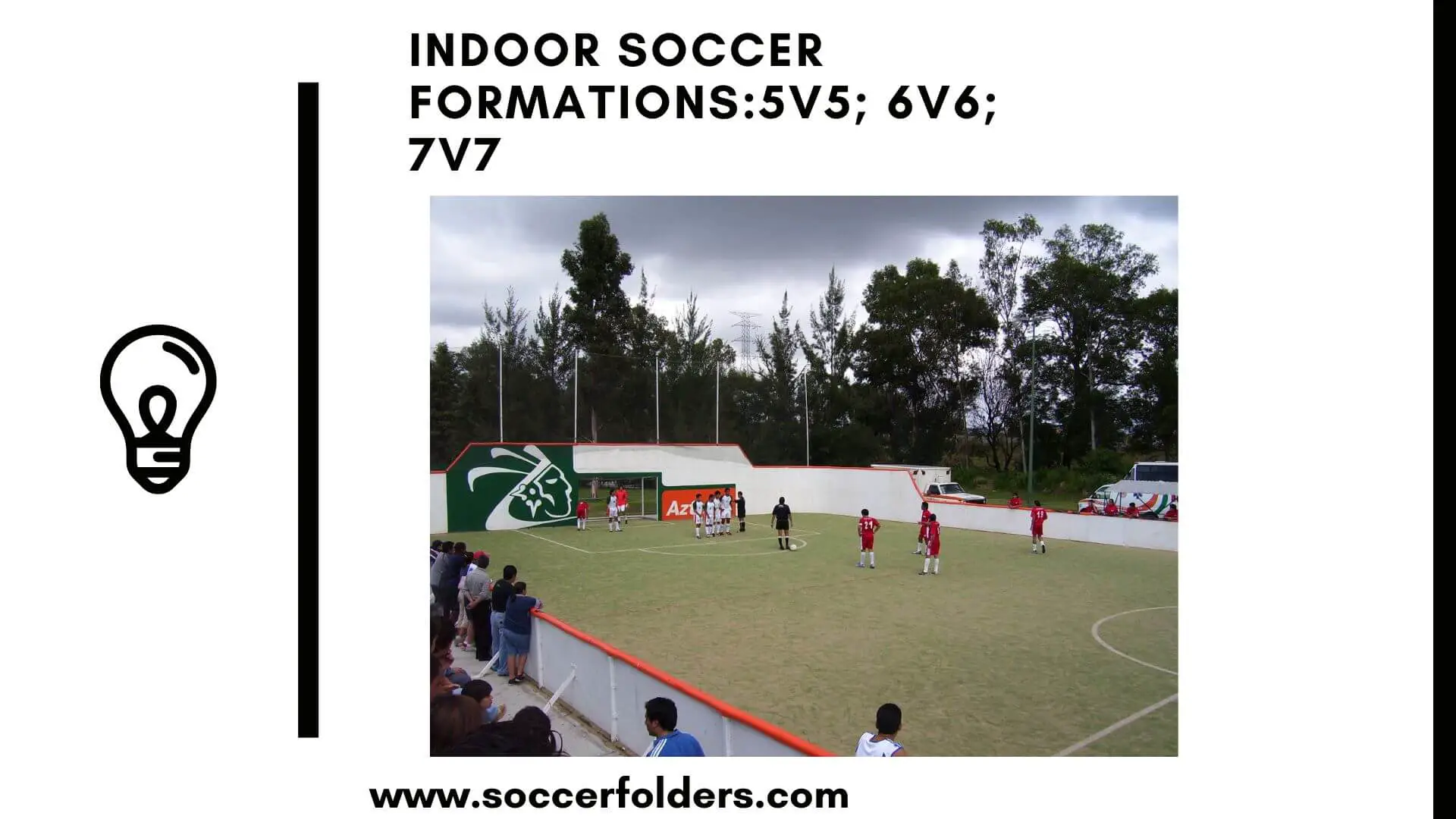Welcome to the dynamic world of indoor soccer, where formations play a pivotal role in shaping your team’s strategy and maximizing your chances of success.
In this article, we’ll explore the intricacies of indoor soccer formations for 5v5, 6v6, and 7v7 matches. By understanding the unique dynamics of each game format and selecting the right formation, you can lead your team to victory.
Get ready to unlock your team’s potential and dominate the indoor soccer pitch.
Quick Navigation
- Overview of 5v5 Indoor Soccer Formations
- Detailed Analysis of 5v5 Indoor Soccer Formations
- Overview of 6v6 Indoor Soccer Formations
- Detailed Analysis of 6v6 Indoor Soccer Formations
- Overview of 7v7 Indoor Soccer Formations
- Detailed Analysis of 7v7 Indoor Soccer Formations
- Key Considerations for Choosing 5v5, 6v6, and 7v7 Indoor Soccer Formations
- Adapting Formations for Different Situations
- Wrap Up
Overview of 5v5 Indoor Soccer Formations
In 5v5 indoor soccer, formations are essential for creating a structured gameplay approach and maximizing the limited space on the field. Let’s dive into some commonly used formations specifically designed for 5v5 matches:
1. Compact 2-1-1 Formation:

The 2-1-1 formation is a popular choice for 5v5 indoor soccer. It involves two defenders, one central midfielder, and one forward. This formation provides a solid defensive foundation, a strong presence in midfield, and an attacking outlet, allowing for quick transitions and efficient ball distribution.
2. The Dynamic Diamond 1-2-1 Formation:
The 1-2-1 formation, often referred to as the diamond formation, is characterized by its dynamic midfield structure. It consists of one defender, two central midfielders, and one forward. This formation allows for precise ball circulation, creative playmaking, and coordinated attacking movements.
3. Flexible 2-2 Formation:
The 2-2 formation offers flexibility and adaptability in 5v5 indoor soccer. It involves two defenders and two midfielders. This formation allows for balanced defensive coverage, control of the midfield battles, and effective transitions between defense and offense.
4. The Attacking 1-3 Formation:
If an aggressive attacking style is your team’s forte, the 1-3 formation might be your go-to choice. It features one forward and three attacking midfielders, creating a potent attacking force. This formation aims to overwhelm opponents with constant pressure, quick passing combinations, and goal-scoring opportunities.
==>> You can also read my article about indoor soccer rules here!
Detailed Analysis of 5v5 Indoor Soccer Formations
Now, let’s delve deeper into each formation, unravelling their intricacies, strengths, and strategies for success in 5v5 indoor soccer:
The Compact 2-1-1 Formation:
The 2-1-1 formation emphasizes defensive solidity, with two defenders forming a compact backline. The central midfielder acts as a link between defense and attack, providing support in both areas of the field. The forward capitalizes on scoring opportunities and works in coordination with the midfield to create goal-scoring chances. This formation excels in maintaining a structured defense while still offering a threat in the attacking third.
The Dynamic Diamond 1-2-1 Formation:
The diamond formation is known for its fluidity and versatility. The single defender anchors the backline, while the two central midfielders control the midfield battles and facilitate quick passing combinations. The forward operates at the tip of the diamond, acting as the primary goal-scoring threat. This formation encourages cohesive teamwork, precise ball circulation, and coordinated attacking movements.
The Flexible 2-2 Formation:
The 2-2 formation provides a balanced approach to 5v5 indoor soccer. Two defenders form a solid defensive base, while the two midfielders control the central areas of the field, both defensively and offensively. This formation offers versatility in transitioning between defense and attack, allowing for effective ball distribution and maintaining control of the game’s tempo.
The Attacking 1-3 Formation:
The 1-3 formation focuses on an aggressive attacking style, aiming to overwhelm opponents with a relentless offensive presence. The alone forward leads the line and is supported by three attacking midfielders who provide creative playmaking, goal-scoring opportunities, and constant pressure on the opposing defense. This formation thrives on quick passing combinations, off-the-ball movements, and exploiting spaces left by the opposition.
Overview of 6v6 Indoor Soccer Formations
In 6v6 indoor soccer, formations play a vital role in shaping your team’s style of play and maximizing your chances of success. Let’s delve into some of the best commonly used formations specifically designed for 6v6 matches:
1. Compact 2-2-1 Formation:

The 2-2-1 formation is an excellent choice for 6v6 indoor soccer. With two defenders providing a solid base, two midfielders controlling the centre of the pitch, and a lone striker leading the attacking line, this formation offers a balanced approach to both offense and defense.
2. Aggressive 3-1-1 Formation:
For teams looking to apply relentless pressure and maintain a high-intensity attacking style, the 3-1-1 formation is a formidable choice. Three defenders create a solid defensive line, while a central midfielder orchestrates play and lone forward spearheads the attack.
3. The Fluid 2-1-2 Formation:
The 2-1-2 formation offers flexibility and fluidity in both offensive and defensive transitions. With two defenders anchoring the backline, a central midfielder controlling the game’s tempo, and two forwards constantly moving and interchanging positions, this formation keeps opponents guessing and creates scoring opportunities.
4. The Attacking 1-2-2 Formation:
If overwhelming your opponents with a relentless attacking approach is your team’s objective, the 1-2-2 formation is an ideal choice. A lone striker is supported by two attacking midfielders, who provide crucial link-up play, while two wide midfielders stretch the opponent’s defense and create space for penetrating runs.
Detailed Analysis of 6v6 Indoor Soccer Formations
Now, let’s delve deeper into each formation, uncovering their intricacies, strengths, and strategies for success:
The Compact 2-2-1 Formation:
With two defenders, two midfielders, and a lone striker, the 2-2-1 formation provides a well-balanced structure for 6v6 indoor soccer. The two defenders create a strong defensive line, while the midfielders control the midfield battles and distribute the ball to the lone striker, who acts as the primary goal-scoring threat. This formation allows for quick transitions from defense to offense and provides stability at the back while maintaining attacking options.
The Aggressive 3-1-1 Formation:
The 3-1-1 formation focuses on an aggressive attacking approach while maintaining defensive stability. Three defenders form a solid defensive line, supported by a central midfielder who controls the game’s tempo and links defense and attack. A lone forward spearheads the attacking line, applying constant pressure on the opposing defense.
The Fluid 2-1-2 Formation:
The 2-1-2 formation is characterized by its flexibility and adaptability. Two defenders maintain a strong defensive presence, while a central midfielder controls the game’s flow, distributing the ball and linking defense with the attack. The two forwards constantly move and interchange positions, and make penetrating runs, creating confusion among the opposing defenders and opening up scoring opportunities.
The Attacking 1-2-2 Formation:
If your team thrives on relentless attacking play, the 1-2-2 formation is a formidable choice. The lone striker leads the line, supported by two attacking midfielders who provide creative playmaking and goal-scoring opportunities. Two wide midfielders stretch the opposing defense, creating space for the attackers to exploit and apply constant pressure.
Overview of 7v7 Indoor Soccer Formations
In 7v7 indoor soccer, formations play a crucial role in optimizing your team’s performance. Let’s delve into some popular formations specifically designed for 7v7 matches:
1. The Balanced 3-2-1 Formation:

The 3-2-1 formation offers a balanced approach to 7v7 indoor soccer. It consists of three defenders, two midfielders, and a lone forward. This formation provides a solid defensive base, control in midfield, and a focal point in the attacking third, facilitating efficient transitions and goal-scoring opportunities.
2. Dynamic Diamond 2-1-2 Formation:
The 2-1-2 formation, known as the dynamic diamond, focuses on midfield control and creativity. Two defenders maintain defensive stability, while the central midfielder dictates the game’s tempo and links defense and attack. Two forwards provide goal-scoring threats and work in tandem with the midfield to create chances.
3. The Aggressive 2-3-1 Formation:
The 2-3-1 formation emphasizes an aggressive attacking style. With two defenders at the back, three midfielders control the centre and wide areas, providing support for both defense and attack. The lone forward leads the line, applying constant pressure on the opposing defense, while the midfielders provide passing options and goal-scoring opportunities.
Detailed Analysis of 7v7 Indoor Soccer Formations
Now, let’s dive deeper into each formation, unravelling their intricacies, strengths, and strategies for success in 7v7 indoor soccer:
The Balanced 3-2-1 Formation:
The 3-2-1 formation provides a solid defensive structure with three defenders forming a cohesive backline. The two midfielders control the midfield battles, offering passing options to both the defense and the lone forward. This formation promotes efficient transitions, defensive stability, and organized attacking play.
The Dynamic Diamond 2-1-2 Formation:
The dynamic diamond formation focuses on midfield dominance and creativity. The two defenders provide a solid foundation at the back, while the central midfielder acts as the playmaker, linking defense and attack. The two forwards, positioned strategically, create goal-scoring opportunities by exploiting spaces and working in coordination with the midfield.
The Aggressive 2-3-1 Formation:
The 2-3-1 formation promotes an aggressive attacking style. The two defenders maintain defensive stability, while the three midfielders support defense and attack. The alone forward leads the line, constantly pressuring the opposition defense, while the midfielders facilitate quick passing combinations and create scoring chances.
See more about the 2-3-1 formation in this video.
Key Considerations for Choosing 5v5, 6v6, and 7v7 Indoor Soccer Formations
Selecting the right formation for your team requires careful consideration of various factors. Keep the following points in mind when choosing a formation:
- Team’s Style of Play: Evaluate your team’s preferred style of play, whether it’s possession-oriented, high-pressing, or quick counter-attacks. Choose a formation that complements and enhances your team’s strengths.
- Player Positions and Strengths: Understand your players’ skill sets and assign positions accordingly. Consider their individual strengths, such as speed, agility, and technical ability, when selecting a formation.
- Opponent Analysis: Analyze your opponents’ strengths and weaknesses to identify a formation that exploits their vulnerabilities while neutralizing their threats. Adjust your formation accordingly to gain a tactical advantage.
- Defensive and Offensive Balance: Strike a balance between defensive solidity and attacking creativity. Ensure your formation provides a structured defense while allowing for fluid movement and effective goal-scoring opportunities.
Adapting Formations for Different Situations
Adaptability is key in 5v5, 6v6, and 7v7 indoor soccer. Consider the following tips for modifying formations based on specific situations:
- Adjusting Formations Based on Scoreline: When leading, a more defensive formation can help protect the advantage, while a more attacking formation might be necessary when trailing and in need of goals.
- Adapting Formations for Specific Opponents: Analyze your opponents’ strengths and weaknesses, and adapt your formation accordingly. Exploit their vulnerabilities while nullifying their critical threats.
- Utilizing Substitutes to Modify Formations: Strategic substitutions can alter the dynamics of a game. Use substitutes to adjust formations during matches, introducing fresh legs and changing player combinations to surprise opponents.
Wrap Up
Mastering 5v5, 6v6, and 7v7 indoor soccer formations is crucial for optimizing your team’s performance.
By carefully selecting a formation that aligns with your team’s style of play, understanding the strengths and weaknesses of your players, and adapting to specific opponents, you can unlock your team’s true potential on the indoor soccer field.
Remember, formations provide structure, but it’s the execution, teamwork, and passion of the players that will ultimately determine success.
Embrace the thrill of 5v5, 6v6, and 7v7 indoor soccer, experiment with formations, and strive for excellence in every match.
If you want, you can read more about indoor soccer here.

